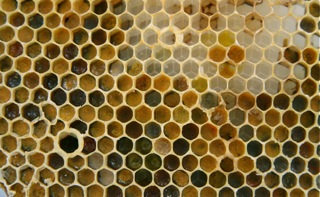Do Your Employees Dance?
 Have you studied bees? Our family has fantastic friend, Dave. Dave keeps bees and supplies us with honey from his local hive. The pollen rich honey does wonders for the hay-fever sufferers in the household.
Have you studied bees? Our family has fantastic friend, Dave. Dave keeps bees and supplies us with honey from his local hive. The pollen rich honey does wonders for the hay-fever sufferers in the household.
Like most people, I’ve not had much reason to study bees. At least, not until I started studying the psychology of language. Dave’s bees do fascinating things, like building the honeycomb pictured here. Bees are viewed as hyper productive, industrious creatures, working away industriously. The hive is the very model of business, full of busy bees.
But did you know that bees spend a fair bit of their time wandering about aimlessly, and a fair bit dancing too? Bees major product is honey. Producing honey requires nectar, which the bees stumble upon by foraging. This is where the dancing comes in. The dancing gets work done efficiently.
When a bee finds a source of nectar it comes back to the hive and does a ‘waggle dance’ for its co-workers. The dance communicates the location of the nectar, indicating the direction and distance. The dance also communicates the type of nectar, by including a sample of the newly found treasure as part of the communication process. The co-workers then mobilize to bring back the rest of the new find.
It is a process of innovation and discovery. A single bee, with the time to wonder, makes a discovery. It then shares the discovery with the hive. The process maximizes the return on the new discovery, while minimizing unfruitful searching by other bees.
Do your employees dance? Do they have the time and tools to communicate where the nectar for your business is to other employees? Do they celebrate and communicate success? It is as important to the modern business as it is to the bee hive.
It always makes me sad when I hear a business shutting down communication channels that employees use – be it instant messaging, video conferencing or a community forum. In the wake of that decision is a hive of workers with less information to make them successful, and a less productive community.
Internal blogs and wikis and open communication channels (rather than closed point to point e-mail systems) are an essential tool for showcasing the steps to success. Did you just make a big business win? Then make sure everyone in the business knows. Let them know why it was a big win, and what enabled it to happen. Do a waggle dance!
It isn’t just for the benefit of current employees. Hopping back to the bees for a minute, the nature of the waggle dance is unique (if you want to know more, check out Karl von Frisch who pioneered the study of bee communication). If you take a different sort of bee and introduce it to the hive, it will not be understood. Although eventually, after some mis steps, the bees will learn to communicate again.
How are new bees in your hive able to learn the language to communicate with the existing bees? Wikis and blogs provide a place for new staff to come and absorb the culture and language of a business. That gets them productive more quickly. They are called business wikis for a reason.
New employee hire orientation isn’t a one off event. It is about binding people into a community and enabling them to be part of it. That is a two way process, requiring good communication tools.
Bees have a specific place where they can come to dance. For some species it might be at the entrance to the hive, for others it is vertically on the comb, but there is a place.
Does your business have somewhere for employees to dance?


I like bees too.
You might enjoy this:
http://www.avantgame.com/McGonigal_WhyILoveBees_Feb2007.pdf
Thanks – I did enjoy that! There still seems to be much to learn in the area of collective intelligence, although really it should be old news. As someone once said “all new news is old news happening to new people”.
We just do it all faster with technology!
Great ideas here. I too think it’s sad to see companies squashing the “dance,” when employees try to use a new social networking tool at work. Allowing employees to stay connected with open communication networks will keep them happy and productive. If only more bosses would see that…
Thank you, Marie. I think people agree the destination is good (open communication), it is the getting there that is painful – facing up to all of the ‘hidden’ issues that have been ignored.
[…] are actually patterns. I was trying to get a close up photograph of a bee (in relation to “Do your employees dance“), when I realised that often life is only random until you study it […]